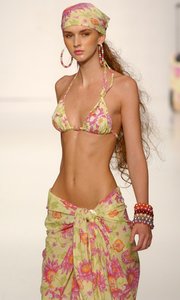Hong Kong Fashion Week
HONG KONG—The new world order of apparel manufacturing has Charlotte Hurst on a serious search. In a little more than 24 hours, the head of development and imports for Los Angeles womenswear company Carol Anderson by Invitation (CAbi) talked to 50 Chinese apparel manufacturers exhibiting at Hong Kong Fashion Week. And she still had two days to go at the event, held July 13–16 at the Hong Kong Exhibition Centre.
Hurst’s goal is to find new Chinese manufacturers to expand CAbi’s overseas production beyond the company’s current 40 percent allotment.
“We are stepping out a little on imports,” she said in between blitzkrieg interviews with factory representatives. “We have been working with people we know, but we thought we should get a bigger picture.”
This was the first time that Hurst and colleague Tessie Que ventured to Hong Kong to check out the Spring/Summer 2005 trade show, which saw a 48 percent jump in exhibitors over last year. In the past, Hurst has dealt with Hong Kong trading companies or relied on wordof- mouth to locate a good manufacturer. But now the company prefers to bypass the trading companies and deal one-on-one with the factories. “We started to go direct to save money,” Hurst said.
She noted she heard about Hong Kong Fashion Week after receiving information in the mail. The timing was right; the company was lining up its Spring 2005 orders. “So far, the show has been great,” Hurst said of the one-stop shopping trip.
Brimming with business
Buyers buzzed around Hong Kong Fashion Week, checking out Asian factories in preparation for the elimination of apparel and textile quotas for the 147 World Trade Organization members on Jan. 1, 2005. The prospect of China being the apparel factory to the world prompted a major jump in exhibitors at the four-day event, launched in 1994 as a follow-up to a decades-old Fall/Winter trade show.
This year, 767 exhibitors signed up, compared with 517 in 2003, when the fear of severe acute respiratory syndrome kept many visitors away. (SARS did not, however, deter many exhibitors who had signed up long before the flu-like virus killed more than 200 people in Hong Kong.) There were only 540 exhibitors at the 2002 Spring/Summer show.
The surprising surge in exhibitors this year left fair organizers optimistic about the future of Hong Kong.
“The opening of China means the fair is a window into China,” said Andrew Leung, chairman of the Federation of Hong Kong Industries and managing director of Sun Hing Knitting Factory Ltd. in Hong Kong.
First-day attendance broke all records. More than 5,300 people showed up, a 41 percent increase over last year, according to fashion week organizers.
Exhibitors—many of whom came from companies based in Hong Kong, China and India— were bent on expanding their businesses into other parts of the world and using the improving economy as a springboard to financial growth.
That’s what prompted Samuel Dong to return to the trade show after a 10-year hiatus. Dong, whose Dons Collection has been headquartered in New York since 1996, does most of his business in the United States, Canada and South Africa. In the United States alone, he sells his line of richly embellished women’s blouses to several department store chains and 2,000 specialty stores. But he wants to expand beyond these countries. “We are looking for new markets in Europe and Japan,” noted the Chinese native, whose family owns a fourstory factory two hours outside of Shanghai in the town of Hangzhou, where all his blouses are made.
Expansion was also on Amanda Loke’s mind. Hong Kong Fashion Week seemed the best place to ramp up business for Amanda Darling, her Hong Kong–based beach and resortwear line. The line, which has only been around for three seasons, sells at specialty stores such as Planet Blue in Malibu, Calif.
“The label is established in Europe,” said Loke, a former childrenswear designer for Esprit Holdings Ltd., the California label that was sold two years ago and is now based in Hong Kong and Germany.
To expand beyond Europe, Loke decided to attend Hong Kong Fashion Week for the first time and get a booth.
The show’s organizers funded 50 percent of her cost to participate in one of the fashion shows, which displayed her collection of crocheted bikinis and miniskirts, peony-print caftans and sarongs, silk pants, fisherman pants, and knit Bardot tops, manufactured in Shenzhen, China, not far from Hong Kong.
Loke said she hopes the exposure helps her to move on to the next level. “Our target,” she said, “is to conquer Asia, America and Australia.”






















